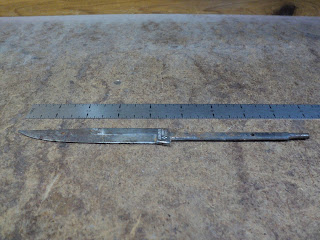* * *
Whoops! --
SUNDAY, JUNE 30, 2013
The post that originally opened up here, and which is still in place below, was all well and good so far as dimensions and methodology were concerned, but the material I used (laminated DVDs) proved not to be up to the forces involved -- my repair failed today after a brief period of use. I have just enough 1/8" thick aluminum material from which to make replacement parts that will be up to the job for certain.
- - -
The Failure --
TUESDAY, JULY 2, 2013
Here's what became of my repair.
I understand now what I failed to fully consider at first. With the nozzle on the end of the hose closed, and full water pressure applied, those two projecting retention nubs on the rotating water supply tube are
forcefully pressing on the inner edge of the retention 'ring'. The material I chose to use just wasn't up to the job -- it shattered completely. (If you scroll down to the third last and second last photos in this post, you'll see how the parts look and relate to one another when installed.)
I suspect that retention 'ring' failure on these hose reels ( Ames ReelEasy) is pretty common as the units age, and the original plastic parts become embrittled.
- - -
New Aluminum Part(s) Nearing Completion --
THURSDAY, JULY 4, 2013
Here's the fly cutting just completed.
The procedure here was really no different than that for the plastic part(s), but the harder material does introduce a bit of difficulty at times.
Note the steel flat clamped across the work. The double-sided tape holding the work to the plywood backing began to come loose near the end of that final cut, so I had to rig that work-holding arrangement to be able to complete the cut.
Now I just have to drill and countersink the four fastener holes, and cut the ring in two.
- - -
New Aluminum Part(s) Ready For Installation --
FRIDAY, JULY 5, 2013
Here's the new retaining 'ring' ready to go.
There's a reason for the asymmetrical cut -- it's so that the two nubs on the water supply tube are never simultaneously at a juncture. That's not an essential feature of the 'ring', but I thought it couldn't hurt to do it that way.
- - -
All Done --
SATURDAY, JULY 6, 2013
I installed the new part(s) and rewound the hose this morning. It works fine now. The final photograph of this post is once again true, and should remain that way for a long time.
* * *
Original Post
[Following is the whole story of my first, ill-fated repair. Everything below is true and correct, except that I had made a poor choice of material for the job. That's been corrected, as per the above.]
- - -
We went to get a hose reel set up this spring, and it had two mystery plastic chunks lying under it.
I really couldn't make out where they came from, and the reel still spun properly, so I thought, "Maybe they're nothing of any consequence, and the hose reel is still usable."
Then I hooked up the water supply and turned it on.
Hmmm. It appears that whatever broke is of some consequence after all. Further investigation is in order.
- - -
Here's where the two chunks of plastic came from.
Those exposed screw heads were the fasteners. Those two pieces that fell out are the two ruined halves of a retaining 'ring' that keeps the water supply tube fully seated in its hub. With the retention gone, the water supply tube dislodged enough that its rotating seals no longer seated correctly -- hence, a big leak.
If I can scrounge up some suitable material, I can fabricate a functional replacement that should work fine.
- - -
Repair Material
Here's some fine, smooth, waterproof material from which to fabricate replacement parts.
I'll laminate those together with
CA adhesive, and I'll have just the blank I need from which to make a new pair of retaining ring halves.
This will be a lovely, happy marriage of high tech and low tech.
- - -
Here's my laminated blank all laid out and set up for machining with the fly cutter.
The blank is adhered to that plywood with double-sided tape. First is the 1 1/16" bore. Then, without disturbing the setup, I'll cut the 3 1/4" diameter perimeter. With those two cuts made, I can unclamp the setup and drill and countersink the four fastener holes.
- - -
Fly Cutting Done
That material machines easily. That was the smoothest fly cutting I've ever done.
- - -
A Curious Snag --
FRIDAY, JUNE 28, 2013
The oddest thing happened while I was drilling the 13/64" fastener holes -- the uppermost disc de-laminated.
At first I thought an entire disc had de-laminated from the stack of three, but it hadn't. The disc
itself is what de-laminated. Oh well, I'll get the part freed from the plywood, and see what I can do with this.
- - -
Nearly There
I re-laminated the layer that came away with CA adhesive, and I've sealed all the edges with the adhesive. The countersinks are done.
I've checked it for fit, and my layout was exactly right. All that's left is to cut it in two places -- it has to be in two pieces to be installable.
- - -
DVDs In Place And Ready To 'Play' --
SATURDAY, JUNE 29, 2013
Here's the completed repair.
The retention is restored, in effectively the same manner as the factory parts provided it. I'll get everything back together and try it out.
- - -
And here we are, hooked up and fully pressurized.
I think I can call that a success.
# # #
# # #

















































